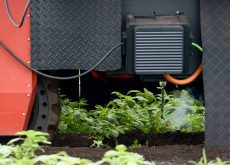Grain carts have become a more common sight in fields over the past few years.
Kellen Huber believes the market will only go up as carts replace grain trucks and semis as the preferred mode of transport from combine to storage.
He started Tri Star Farm Services, based in Grand Coulee, Sask., to sell new and used carts, and he’s focusing on brands that aren’t as common.
At the Western Canada Farm Progress Show last month, he displayed both Kinze and CrustBuster carts.
Read Also

Bird repellent gets emergency approval for sunflowers
Bird repellent gets emergency approval for sunflowers
Kinze prices are at the upper end of the scale while CrustBusters are more economical.
“CrustBuster will sell well this year,” he predicted during a lull in traffic at the show.
“They’re more attractive to first time buyers who want to start with a more affordable cart.”
But the Kinze model – a 1050 Harvest Commander on tracks – drew a lot of interest, too.
In a year like this, when wet weather dogged seeding and now spraying seasons, equipment on tracks performs better in the field, Huber said.
“It’s the ultimate in flotation.”
There was a time when only custom combine operations used grain carts. But Huber said they offer efficiency when farmers are seeding larger acreages and therefore taking off bigger yields.
“We’ve got larger equipment, bigger farms, shorter harvesting times,” he said.
The Kinze 1050 empties in about two minutes.
Maintenance on grain carts is easier and cheaper than fixing a semi that goes down during the busy harvest season, he added.
That said, a cart on tracks like the Kinze could mean more maintenance and it costs a lot more money.
Huber is importing used Kinze models for two reasons.
“I can get the new stuff, but it’s sold out. And, (exchange on) the dollar has been a factor.”
Canadian manufacturers face tough competition from their U.S. counterparts due to the rising dollar and labour and steel costs, he said.

















